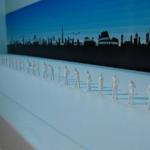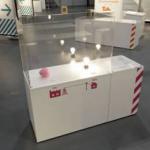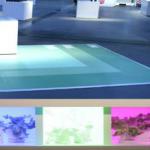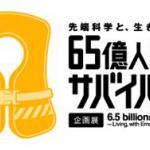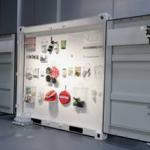EXTRA, the marketplace for scientific touring exhibitions.
Exhibit Topics
Step 1. Understand Now: Recognition of the current situation and expressing concerns using data.
Step 2. Next Steps: Innovations designed to move our daily lives to the next stage are introduced. S
tep 3. Stepping into the Future: Cutting-edge research topics promoted in consideration of life 20- 50 years form now.
*Mini-version (200m2) is also available. (Food and Energy)
*The exhibition can be produced in other languages.
ZONE1: To Live Tomorrow
CHECK IN: What would you need if you have to live alone?
ZONE2: For Living in 50 Years
1. Food of 6.5 Billion
Now: Polarization between satiation and starvation
Next: Technologies to tackle starvation: GM food, plant factory, and bringing life to wasteland
Future: Technologies to tackle satiation: Prion-free beef, Iron-enriched rice, CoQ10 rice and Cultivation using LED
2. Tools of 6.5 Billion
Now: Tools consisting of various materials has a great effect on environment by its production process: mobile phone
Next: High-functional tools can be produced by developing material itself: nano-carbon, atomic switches, Green and sustainable chemistry, and Slide-ring gel
Future: Research is underway in an effort to create manmade materials based on the structure and functions of living bodies: molecular motors and self-organization; and its risk evaluation
3. Living Environment of 6.5 Billion
Now: Effect on the environment by population increase
Next: For recyclable society: Eco-House and Biomass towns
Future: For material circulation and good living: Mini-Earth (Closed Ecology Experiment Facilities) and space agriculture
4. Energy of 6.5 Billion
Now: Depletion of resources and conspicuous increase of CO2
Next: Natural energy sources: Solar power, Geothermal energy, Wind power, Biomass, and Hydrogen
Future: Ultimate new energy: artificial sun, photocatalysts, Space Solar Power System, and global energy network
ZONE3: What Does It Mean to Survive?
CHECK OUT: 6.5 billion people survive over generations among changing environment, and individuals’ genes have hints to survive: “thrifty genes” and CCR5 gene.
This exhibition was featured at Miraikan from 28 October 2006 to 5 February 2007. http://www.miraikan.jst.go.jp/e/sp/survival/

